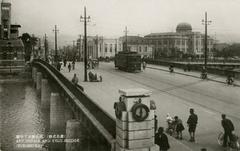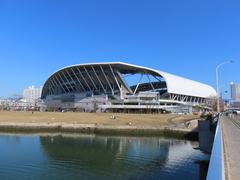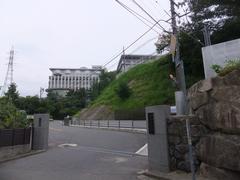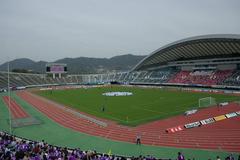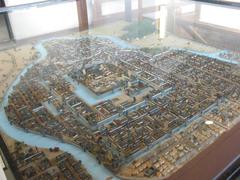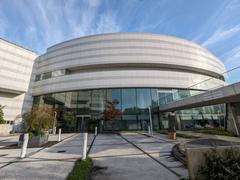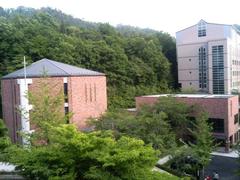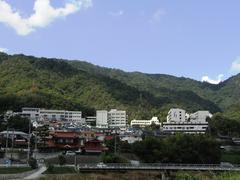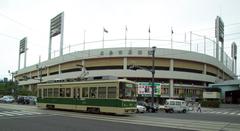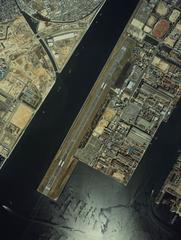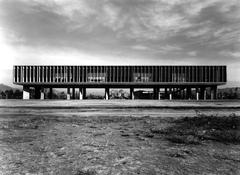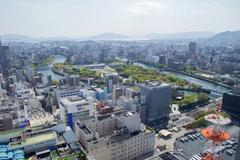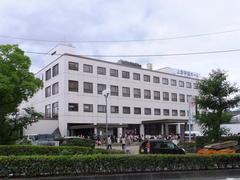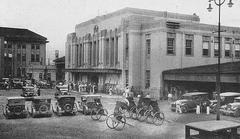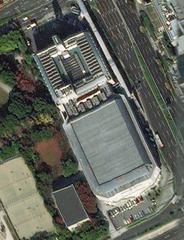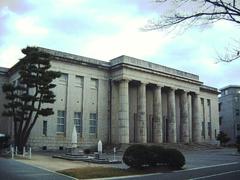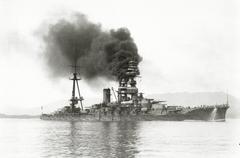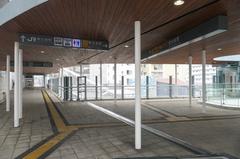Hiroshima City Museum of Contemporary Art: Comprehensive Visitor Guide (2025)
Date: 14/06/2025
Introduction
The Hiroshima City Museum of Contemporary Art (Hiroshima MOCA) stands as a pioneering institution in Japan’s postwar cultural landscape. Established in 1989, it is the country’s first public museum dedicated exclusively to contemporary art. Situated in the tranquil Hijiyama Park, the museum embodies Hiroshima’s resilience and commitment to peace, providing visitors with both world-class art and a contemplative space that honors the city’s history.
Designed by renowned architect Kisho Kurokawa, Hiroshima MOCA seamlessly merges postmodern architectural forms with symbolic references to Japanese tradition and the city’s narrative of renewal. It offers not only a rich permanent collection and dynamic special exhibitions but also extensive educational and community engagement programs. Its proximity to historical sites like Hiroshima Peace Memorial Park and the Atomic Bomb Dome further enriches the visitor experience, making it a must-see for art lovers, history enthusiasts, and travelers seeking meaningful cultural engagement (official website, Hiroshima Architecture Exhibition, Setouchi Travel).
Contents
- Founding and Historical Context
- Architectural Significance
- Mission and Core Objectives
- Collection Highlights and Thematic Focus
- Special and Rotating Exhibitions
- The Hiroshima Art Prize
- Outdoor Sculptures and Site-Specific Installations
- Educational and Community Engagement
- Visiting Hours, Tickets, and Accessibility
- Getting There
- Nearby Attractions and Travel Tips
- Visitor Experience and Amenities
- Frequently Asked Questions (FAQ)
- Conclusion and Visitor Recommendations
- Sources
1. Founding and Historical Context
The Hiroshima City Museum of Contemporary Art (広島市現代美術館, Hiroshima-shi Gendai Bijutsukan) was established in 1989, reflecting Hiroshima’s desire to reimagine its identity as a center for global dialogue and creativity in the wake of the 1945 atomic bombing. Chosen for its symbolic resonance, Hijiyama Park provides a peaceful setting for this cultural landmark, away from the city’s busiest districts yet deeply connected to its narrative of resilience and hope. The museum’s founding coincided with Japan’s period of economic growth and increasing interest in international contemporary art (official website).
2. Architectural Significance
Vision and Design
Kisho Kurokawa, a founding member of the Metabolist architectural movement, designed Hiroshima MOCA as a bridge between past and present, local and global. His postmodern vision is evident in the building’s geometric forms and use of traditional Japanese motifs (Wikipedia).
Structural Features and Symbolism
The museum’s structure comprises interlocking cylindrical and rectangular volumes, reminiscent of traditional Japanese storehouses (kura). Materials such as concrete, glass, and stone create a contemplative atmosphere, while panoramic terraces offer sweeping views of Hiroshima, symbolizing hope and reflection.
Integration with the Landscape
Positioned atop Hijiyama Hill, about 70 meters above sea level, the museum harmonizes with its natural surroundings. Large windows and outdoor walkways provide constant visual connections to the city and park, particularly stunning during cherry blossom season (trundlejapan.com, hiroshimavibes.com).
3. Mission and Core Objectives
Hiroshima MOCA’s mission is to:
- Collect, preserve, and exhibit post-1945 contemporary art from Japan and abroad.
- Foster dialogue between contemporary art and Hiroshima’s historical, social, and cultural context.
- Support emerging artists and innovative practices.
- Serve as a center for education, community engagement, and international cultural exchange (Wikipedia).
A central theme is exploring peace, resilience, and creativity in the face of adversity, with many exhibitions directly addressing Hiroshima’s legacy.
4. Collection Highlights and Thematic Focus
The museum holds approximately 1,700 works, with a strong focus on art related to Hiroshima’s history and broader global themes of peace and human coexistence (Setouchi Travel, GetHiroshima). Highlights include works by Henry Moore, Andy Warhol, Frank Stella, and leading Japanese artists. Thematic exhibitions rotate regularly, often exploring memory, trauma, and reconciliation (Trip to Japan, Japan Experience).
5. Special and Rotating Exhibitions
Hiroshima MOCA’s special exhibitions feature both Japanese and international artists, often engaging with Hiroshima’s legacy. Recent and upcoming exhibitions include:
- “A Reflection on the Sublime” (April–August 2024) (NACT)
- “Before/After” (March–June 2023) (Art-It Asia)
- “Commemorating the 80th Anniversary of the Atomic Bomb: Between Memories and Objects” (June–September 2025) (Tokyo Art Beat)
The museum also hosts “Collection Highlights” and “Collection Relations” programs, which pair permanent collection works with guest artists and related materials (Art-It Asia).
6. The Hiroshima Art Prize
Established in 1989, the triennial Hiroshima Art Prize honors artists whose work contributes to the advancement of peace through contemporary art. Past laureates include Yoko Ono, Cai Guo-Qiang, Shirin Neshat, Daniel Libeskind, Issey Miyake, and Alfredo Jaar (Japan Experience). Each recipient is celebrated with a major solo exhibition, reinforcing Hiroshima’s status as an international art hub.
7. Outdoor Sculptures and Site-Specific Installations
The museum’s sculpture garden, set amidst Hijiyama Park’s cherry trees and lawns, features 17 outdoor works. Notable pieces include Henry Moore’s “Arch,” Donald Judd’s minimalist forms, and sculptures by celebrated Japanese artists (trundlejapan.com). The open-air gallery is free to explore and encourages visitors to encounter art in harmony with nature (hiroshimavibes.com).
8. Educational and Community Engagement
Education and outreach are central to Hiroshima MOCA’s mission. The museum offers:
- Guided tours, artist talks, and hands-on workshops for all ages.
- School programs and community events focusing on peace, creativity, and intercultural understanding.
- Collaborations with local and international partners on projects addressing social issues like peacebuilding and sustainability.
The museum’s café “Arch” and shop offer locally sourced refreshments and art-inspired souvenirs, enhancing the visitor experience (Setouchi Travel).
9. Visiting Hours, Tickets, and Accessibility
- Opening Days: Tuesday to Sunday; closed Mondays (except national holidays) and during exhibition changeovers.
- Opening Hours: 9:30 AM – 5:00 PM (last admission at 4:30 PM; some special exhibitions may open at 10:00 AM).
- Admission Fees: Vary by exhibition, typically 300–1,000 yen. Discounts for students, seniors, and free entry for children up to high school age with a paying adult. Outdoor sculpture garden is free.
- Where to Buy Tickets: At the museum entrance or online via the official website.
- Accessibility: Fully wheelchair- and stroller-accessible, with ramps, elevators, and baby-changing facilities. Assistance available upon request (MLIT).
10. Getting There
- Location: Hijiyama Park, about 3 km south of Hiroshima Station.
- By Tram: Hiroshima Electric Railway (Line 5 or 6) to Hijiyama-shita Station, then a 10-minute uphill walk.
- By Bus: Several city buses stop near Hijiyama Park.
- By Car: Limited parking; public transport is recommended.
11. Nearby Attractions and Travel Tips
- Hiroshima Peace Memorial Park & Atomic Bomb Dome: About 2 km away, ideal for a combined visit.
- Shukkeien Garden: A historic Japanese garden near Hiroshima Station.
- Hiroshima City Manga Library: Located within Hijiyama Park, a must for manga enthusiasts.
- Best Times to Visit: Late March–early April (cherry blossoms); November–early December (autumn foliage).
- Visitor Tips: Wear comfortable shoes for hilly terrain; check the museum calendar for special events; photography is permitted outdoors and in most exhibition areas (no flash/tripods).
12. Visitor Experience and Amenities
- Café “Arch”: Offers meals and desserts in a tranquil setting.
- Museum Shop: Sells art books, prints, and local souvenirs.
- Studio and Video Corner: Interactive spaces for workshops and multimedia art.
- Guided Tours: Available by request; English language support varies.
- Facilities: Accessible restrooms, baby-changing stations, and family-friendly amenities.
13. Frequently Asked Questions (FAQ)
Q: What are the museum’s opening hours?
A: 9:30 AM–5:00 PM (last entry 4:30 PM), Tuesday to Sunday. Closed Mondays and during exhibition changeovers.
Q: How much are tickets?
A: Adults: 300–1,000 yen depending on the exhibition; discounts for students/seniors; children up to high school age free with paying adult.
Q: Is the museum wheelchair accessible?
A: Yes, with ramps, elevators, and accessible restrooms.
Q: Can I take photos inside?
A: Allowed outdoors; indoor rules vary by exhibition—check signage or ask staff.
Q: Are there guided tours in English?
A: Guided tours are offered; English support may be limited.
Q: How do I get there?
A: By tram to Hijiyama-shita Station or by bus; then a short uphill walk through Hijiyama Park.
Q: Are there free areas?
A: Yes, the outdoor sculpture garden is free and open to the public.
14. Conclusion and Visitor Recommendations
The Hiroshima City Museum of Contemporary Art stands at the intersection of history, creativity, and peace. Its thoughtfully curated exhibitions, diverse collection, and engagement with both local and global communities make it a vital cultural institution. Whether you are seeking reflection, inspiration, or a deeper understanding of Hiroshima’s legacy, a visit to MOCA is highly recommended.
For up-to-date information on exhibitions, hours, and events, consult the official website. The Audiala app can further enhance your experience with audio guides and event notifications. Combine your museum visit with nearby historical sites for a comprehensive exploration of Hiroshima’s cultural landscape.
15. Sources
- This is a sample text. (official website)
- This is a sample text. (trundlejapan.com)
- This is a sample text. (Setouchi Travel)
- This is a sample text. (Hiroshima MOCA Official Website)
- This is a sample text. (Hiroshima Architecture Exhibition)
